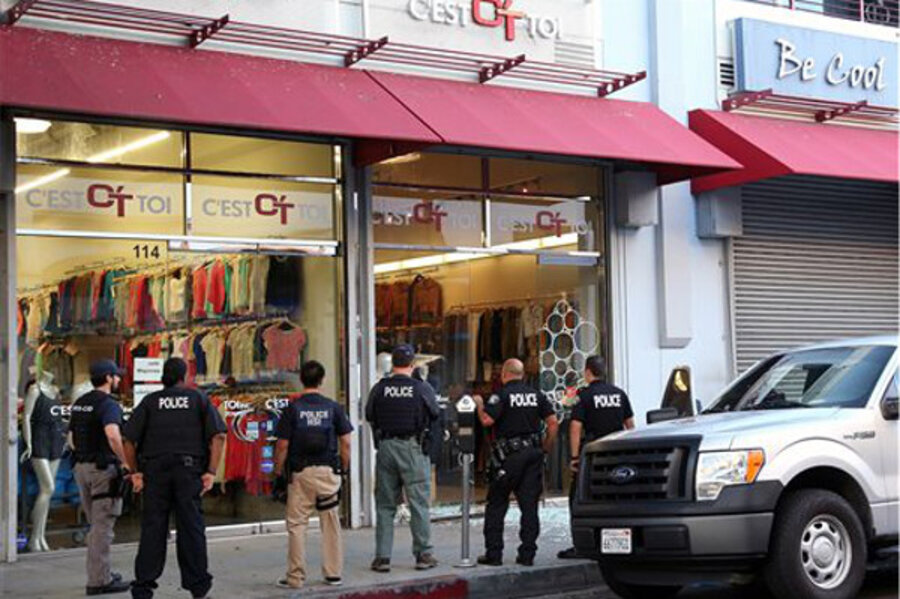Fashion district raid finds $100 million of laundered Mexican cartel ransom money
Loading...
| LOS ANGELES
A family pleaded for help from the FBI when an American who delivered cocaine for a drug cartel was kidnapped and held captive in 2012 in Mexico.
After the family paid a $140,000 ransom, the man was freed and returned to the United States. However, it wasn't the end of the case that led FBI agents to what they now believe was a scheme to launder drug money in the fashion district of Los Angeles and return the cash to a Mexican cartel.
Earlier this week, dozens of businesses were raided by the FBI, homeland security and other officials in an even broader crackdown on money laundering in the country's second most populous city.
Authorities seized more than $100 million and searched roughly 50 of the 3,000 business in the district, the US attorney's office said.
Nine people were arrested in connection with three indictments on charges related to money laundering and other financial violations, including the case involving the ransom payment.
Federal prosecutors allege the Sinaloa cartel used the tactic to launder the ransom that was paid to fashion district wholesaler QT Fashion then divvied up among more than a dozen district businesses.
Four days later, the kidnapped man — who was not identified by US authorities — was back in the US, telling authorities he had been assaulted with firearms and chainsaws, electrocuted and tortured during his captivity, according to an FBI search warrant affidavit obtained Thursday by The Associated Press.
No federal charges have been filed involving the alleged drug conspiracy, but the man could face a 22-year sentence in connection with a 2008 arrest on a drug-related case in Los Angeles County, the affidavit said.
The FBI later found that some of the blood in the photos sent to his relatives was doctored — apparently a common practice used to frighten victims' family into paying ransom, the court papers said.
The harrowing account mirrors those of other Americans who were kidnapped in Mexico during heated clashes between rival cartels several years ago.
The FBI's San Diego office was handling 25 to 30 cases a year between 2008 and 2011 in the area surrounding Tijuana, most involving victims abducted while visiting family or doing business, said Keith Slotter, who was special agent in charge of the FBI's San Diego office at the time.
"Often times it was they had a relative who was involved in the drug trade and this would be some kind of payback or leverage associated with that," Slotter said.
Since Mexico tightened financial regulations in 2010, the cartels have increasingly turned to international trade to launder drug money by delivering dollars to companies in the US for goods exported to Mexico, then recovering the funds in pesos once the products are sold in a scheme known as a black market peso exchange, US authorities said.
Thom Mrozek, a spokesman for the US attorney's office, said he was unaware of other cases involving the laundering of ransom payments. He declined to discuss the prevalence of kidnapping by cartels.
In a 2013 interview with an FBI agent, QT Fashion manager Sang Jun Park acknowledged counting money brought to the company in December 2012 but denied any involvement in the kidnapping, the affidavit states. He said the company sent clothes to Mexican apparel company Maria Ferre on credit and received payments in bulk cash.
Park is one of six defendants indicted in the case unsealed Wednesday against QT Fashion and Maria Ferre. His lawyer, John McNicholas, declined to comment on the allegations.
While investigating the kidnapping case, federal agents say they found that QT Fashion received $1.5 million at the direction of Maria Ferre in the 16 months through September 2013 and funneled it through more than a dozen other fashion district businesses.
A person who answered the phone at Maria Ferre in Mexico said the company would issue a statement later Thursday then hung up before the AP could get her name.
The owner, Luis Ignacion Munoz Orozco, is a well-known Sinaloa businessman and was Sinaloa state leader for the National Chamber of Commerce.
The AP tried to contact Munoz by email and Facebook, but he did not immediately respond.
___
Associated Press writers Elliot Spagat in San Diego and Martin Duran in Culiacan, Mexico, contributed to this report.







